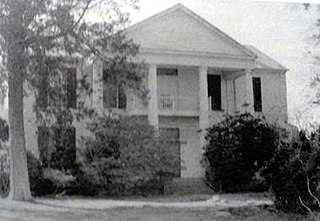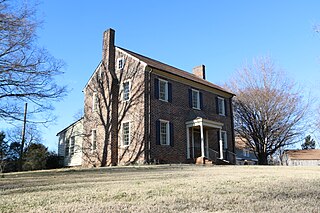
William Alexander Graham was a United States senator from North Carolina from 1840 to 1843, a senator later in the Confederate States Senate from 1864 to 1865, the 30th governor of North Carolina from 1845 to 1849 and U.S. secretary of the Navy from 1850 to 1852, under President Millard Fillmore. He was the Whig Party nominee for vice-president in 1852 on a ticket with General Winfield Scott.

The North Carolina State Capitol is the former seat of the legislature of the U.S. state of North Carolina which housed all of the state's government until 1888. The Supreme Court and State Library moved into a separate building in 1888, and the General Assembly moved into the State Legislative Building in 1963. Today, the governor and his immediate staff occupy offices on the first floor of the Capitol.

Stagville Plantation is located in Durham County, North Carolina. With buildings constructed from the late 18th century to the mid-19th century, Stagville was part of one of the largest plantation complexes in the American South. The entire complex was owned by the Bennehan, Mantack and Cameron families; it comprised roughly 30,000 acres (120 km2) and was home to almost 900 enslaved African Americans in 1860.

The John Coltrane House is a historic house at 1511 North 33rd Street in Philadelphia, Pennsylvania, USA. A National Historic Landmark, it was the home of American saxophonist and jazz pioneer John Coltrane from 1952 until 1958. On his death in 1967 the house passed to his cousin, who sold it in 2004. Efforts for restoration and reuse as a jazz venue are struggling. In 2022, two of Coltrane's sons filed a lawsuit contesting the ownership of the home.

Cedar Haven was a historic Greek Revival plantation house located near Faunsdale, Alabama. It was built in 1850 by Phillip J. Weaver. Weaver was a prominent merchant and planter. He was born in Mifflintown, Pennsylvania in 1797 and relocated to Selma from Uniontown, Maryland in 1818. He ran a very successful store in Selma and also maintained a home there. Weaver was the paternal grandfather of the artist Clara Weaver Parrish.

The House in the Horseshoe, also known as the Alston House, is a historic house in Glendon, North Carolina in Moore County, and a historic site managed by the North Carolina Department of Natural and Cultural Resources' Historic Sites division. The home, built in 1772 by Philip Alston, was the site of a battle between loyalists under the command of David Fanning and patriot militiamen under Alston's command on either July 29 or August 5, 1781. The battle ended with Alston's surrender to Fanning, in which Alston's wife negotiated the terms with the loyalists.
The Aycock Birthplace, also known as the Charles B. Aycock Birthplace, is a historic home in Wayne County, North Carolina, and a historic site belonging to the North Carolina Department of Natural and Cultural Resources' Historic Sites division. The property was the location of the birth of Governor Charles Brantley Aycock in 1859, and exhibits at the historic site serve to tell the story of the Governor's political career and the education reforms he enacted while in office. It was built about 1840, and is a one-story weatherboard dwelling on a brick pier foundation. It has a gable roof and exterior end chimneys.

The 1774 Alexander Rock House in Charlotte, North Carolina, US, is the oldest house in Mecklenburg County and was added to the National Register of Historic Places in 1970. Originally built by the Alexander Family who finished construction in 1774, the Rock House and its various outbuildings have had many owners over the years with The Charlotte Museum of History being its steward today.
The Dr. Alexander C. Brabson House is a historic house in rural Macon County, North Carolina. It is located off Academy Road near the community of Otto.

Boggan-Hammond House and Alexander Little Wing is a historic home located at Wadesboro, Anson County, North Carolina.

Col. Silas Alexander Sharpe House is a historic home located at Statesville, Iredell County, North Carolina. The house was built between about 1860 and 1865, and is a two-story, three-bay, Classical Revival style frame dwelling. It features an elegant two-story, front portico with clustered columns.

The Neal Somers Alexander House is a historic house located at 5014 North Sharon Amity Road near Charlotte, Mecklenburg County, North Carolina.

William T. Alexander House is a historic plantation house located near Charlotte, Mecklenburg County, North Carolina. It built between 1820 and 1830, and is a two-story, three-bay, brick dwelling with Federal and Georgian style design elements. It has a side-gable roof, sits on a granite foundation, and a center-bay porch added in the 1920s.

Bishop John C. Kilgo House is a historic home located at Charlotte, Mecklenburg County, North Carolina. It was built in 1915, and is a two-story, three-bay, frame dwelling with Colonial Revival and Bungalow / American Craftsman design elements. It has a hipped roof, cubic main block with a later, 1950s rear, two-story, two-bay, gable-roofed addition. The front facade features a center bay, one-story entry porch with Tuscan order columns. It was built for Bishop John C. Kilgo (1861–1922), bishop of the Methodist Episcopal Church, South.

Alexander Kelly House, also known as the John B. Kelly House, is a historic plantation house located near Carthage, Moore County, North Carolina. It was built in 1842, and is a two-story, five-bay, double pile, Federal / Greek Revival style frame dwelling. The house rests on tapered, hewn brownstone piers and has a deep hip roof. The front facade features a three-bay pedimented porch.
Alexander Long House is a historic plantation home located near Spencer, Rowan County, North Carolina. Alexander Long, the original owner of the home, owned the ferry that crossed the Yadkin River one mile east of the home's location. The property was built in about 1783 and once boasted a 2,500 acre spread. It was listed on the National Register of Historic Places in 1972.

Dr. Evan Alexander Erwin House is a historic home located at Laurinburg, Scotland County, North Carolina. It was built in 1904, and extensively remodeled in 1939 in the Classical Revival style. It is a two-story, five-bay, double pile, frame dwelling, with one-story side-gable flanking side wings. It features a two-story front porch with a flat roof and supported by four square slender wood columns with Tuscan order caps. Also on the property is a contributing two car garage.

Hawkins-Hartness House is a historic house in Raleigh, North Carolina. It was built around 1880 in the Eastlake style. It houses the office of the Lieutenant Governor of North Carolina.

Lackey-Overbeck House, also known as the Lackey-Cockefair-Overbeck-Matheis House, is a historic home located at Cambridge City, Wayne County, Indiana. It was built about 1835, and is a two-story, three-bay, frame dwelling with Federal and Greek Revival style design elements. A two-story rear wing was added about 1850.





















